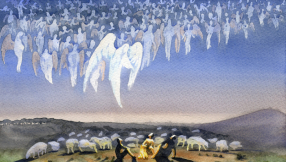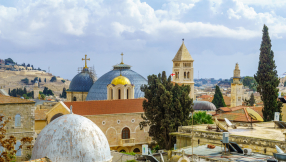
Museums are special places. To a certain extent - at least in our secular world - they've replaced the Church as the domicile of solace, reflection, and inspiration.
And a great museum is all of this and more, giving the participant ample room to muse, consider, and ponder the meaning of art, history, ideas, and life, causing one to interface with society and culture in a unique way.
Now hear me out: I'm not saying that museums have replaced the Church. They haven't. As one who actually looks forward to weekend services, I'm not about to say that the "Church is dead." It isn't. It's alive and well, just like the God it seeks to follow.
But the museum is a unique experience, one that affords a larger perspective on existence. As inhabitants in the world, museums give people the microscopic view of civilization and a macroscopic understanding of our place within it, large and small worldviews; it can all be found in a museum.
On a recent trip to Kansas City, I was able to take in the view of civilization at two art museums: The Kemper Museum of Contemporary Art and the Nelson-Atkins Museum of Art.
It just so happened that the day before we attended the Kemper Museum of Contemporary Art that its namesake, R. Crosby Kemper, died on January 2nd, 2014. The Kansas City Star reported on Mr. Kemper's support of the museums as follows, "Kemper appreciated nearly all the arts.
"His bank's art collection included works by Andrew and James Wyeth, Thomas Hart Benton, Roy Lichtenstein, Andy Warhol and Alexander Calder.
"He donated liberally to the Nelson-Atkins Museum of Art.
"'Crosby's passion for American art resulted in stellar contributions, including John Singer Sargent's Mrs. Cecil and Jerusalem from the Mount of Olives by Frederic Edwin Church,' said Julián Zugazagoitia, chief executive and director of the Nelson-Atkins Museum.
"Recently, Kemper was instrumental in funding the museum's Shuttlecarts that ferry visitors through its Bloch building."
I was appreciative of the legacy Kemper left as I walked the halls of both museums, a recipient of his foresight and investments.
I soaked in the "Dressed Up" exhibit at the Kemper Museum, being impressed with the portraiture work of Hope Gangloff. And at the Nelson-Atkins Museum, I wandered through the recent exhibit of photographer David Douglas Duncan's work entitled, "Celebrating Picasso."
And-as my tradition when visiting the Nelson-Atkins-I paid a visit to the works of Picasso, Georges Rouault, Joan Miro, Robert Rauschenberg, Van Gogh, Andy Warhol, and many more. I even photo bombed-with my niece in tow-a few of the works.
But I must admit that my favorite section of the museum is the work of Thomas Hart Benton (1889-1975), the Missouri native whose home and studio is not far from the Nelson-Atkins Museum. Often despised by many art critics as narrow minded and 'regional,' his work in recent years has spawned much admiration, particularly as the teacher of America's greatest contemporary painter, Jackson Pollock (1912-1956).
Noted American biographer, Henry Adams, writes in this book, "Tom and Jack," about the connection between the two great artists, stating, "Benton influenced Pollock's ideas about the role of the artist, about how to promote oneself, about how to stand out from the pack, about how to take European ideas and convert them into something distinctively American."
Two great artists-Benton and Pollock-housed in one museum.
So what is it about the museum that draws people to its halls, rooms, and corridors? Maybe it's the "living tradition" of art that attracts us. Daniel Siedell writes in his book, "God in the Gallery," "Museum art, then, is a profoundly historical practice with a developed tradition, a living tradition of the dead rather than a dead tradition of the living." Maybe I enjoy art because I like tradition, particularly a living tradition.
Or maybe it's the practice of honing my mind and sensibilities, something akin to a cultural training that pulls me to the museum. It is true that I like to massage my mind by meditating on meaning and purpose found in the arts.
Concerning this, Siedell writes: "Art is not only a cultural practice, it is also an institutional practice. Therefore, any discussion of art must take into account its institutional framework.Modern art and its living tradition exists not only invisibly in the hearts and minds of its practitioners and participants but also embodied, meditated in and through its visible public institutions."
If we take Sidell at his word, there is the heart-mind component to art enjoyment that plays out in the museum.
Yet, as I read Sidell's above quote, something jumps out at me relating to the heart and mind influence of art: art "exists.invisibly in the hearts and minds of its practitioners. but also embodied.through visible public institutions."
When you pause to think about the quote, it sounds a lot like the Church. Is the museum the secular means of inserting something profound, but manmade, in the place of the eternal? Maybe, maybe not.
To a certain extent, art museums have mimicked the Church. For Sidell's quote expresses exactly what the Church is-or should be-about: Christians are the visible representation of the invisible God. As practitioners and participants of the Christian faith, we make visible the unseen God-through our actions, words, works, and hope of the world to come.
The great hymn, "Immortal, Invisible, God Only Wise," states it well: "Immortal, invisible, God only wise, in light inaccessible hid from our eyes, most blessed, most glorious, the Ancient of Days, almighty, victorious, thy great name we praise."
The hymn, written by Walter Smith, references the Apostle Paul's praise in I Timothy 1:17: "Now unto the King eternal, immortal, invisible, the only wise God." As the Church we declare the great and wonderful certainty of God's work in the world: past, present and future. The Church is a living museum of a different sort: God's collected work in the lives of his people and world.
And like the vast collections of artwork displayed in buildings throughout the world, the Church is on display for the world to see. Like a piece of artwork is a witness to the prestige of the museum and collector, the Church is to be a witness to the reality of God in our world.
Jesus, speaking to the disciples, states, "But you will receive power when the Holy Spirit has come upon you, and you will be my witnesses in Jerusalem and in all Judea and Samaria, and to the end of the earth" (Acts 1:8). The Church should be the witness of the Great Artist.
And just as a museum has unique characteristics concerning its collection of art, so too should the Church. But rather than artwork, love is our characteristic. Jesus said, "By this all men will know that you are My disciples, if you have love for one another." Instead of artwork, love is the greatest display of our unique characteristic in the world, being on display for all to see.
And one final comparison between a museum and Church: both specialize in artwork. For the museum it's statues, paintings, assemblages, performance art, and the like. But for the Church its people that God specializes in. The Apostle Paul writes that the Church is God's artwork. Ephesians 2:10 states, "For we are God's masterpiece. He has created us anew in Christ Jesus, so we can do the good things he planned for us long ago."
The word for "masterpiece" is "poiema", meaning "poem" or "piece of art, such as a tapestry." The Church is God's creation-His artwork-to fulfill all the good things he's planned for the world.
I wonder if Christians have invested in the Church like R. Crosby Kemper did in the museums in Kansas City. Have we put the time, energy, and finances into making the Church the greatest "living museum" the world has known? Furthermore, have we let our "love for one another" be the characteristic others have come to see, the quality that is on display?
One other point of thought: let it be acknowledged that this "living museum"-the Church-isn't just about beautiful works of manmade art (which it has inspired and created throughout the centuries); but about the people, God's poems, and God's ultimate building: His kingdom. And this kingdom is being constructed-one life at a time-into the greatest work of art the universe can only imagine: the new heaven and Earth.
Now that's a museum that I can't wait to see!
This year take some time to walk through a museum or two. But more importantly, take the time to stand in awe of the Master Artist during a Church service, allowing Him to fashion you into the greatest piece of art in the world: a member of his Church, supporting it with your time, talent, and resources. And in doing so, ensuring that it is a "living museum" worth visiting.













